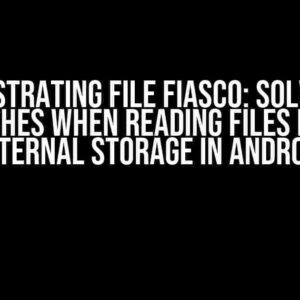As an Android developer, you’ve likely heard of Proguard, the powerful tool that helps optimize and obfuscate your code. But have you ever wondered whether you need to add Proguard rules when developing Android libraries? In this article, we’ll dive into the world of Proguard and explore the importance of adding rules when creating Android libraries.
What is Proguard?
Proguard is a popular tool used in the Android development process to optimize and obfuscate code. It helps reduce the size of your application, making it more efficient and secure. Proguard achieves this by renaming classes, methods, and fields, making it difficult for hackers to reverse-engineer your code.
When you build an Android application, Proguard is enabled by default, and it processes your code to remove unnecessary classes, methods, and fields. This results in a smaller and more optimized application.
Why do I need to add Proguard rules for Android libraries?
When developing an Android library, you might think that Proguard rules are not necessary since the library will be used by other applications. However, this is a common misconception. Adding Proguard rules to your Android library is crucial for several reasons:
- Code obfuscation: By adding Proguard rules, you ensure that your library’s code is obfuscated, making it difficult for others to reverse-engineer or steal your intellectual property.
- Code optimization: Proguard rules help optimize your library’s code, reducing its size and improving performance.
- Compatibility: Without Proguard rules, your library might not work as expected in other applications, leading to compatibility issues.
- Security: By adding Proguard rules, you protect your library from potential security vulnerabilities.
How to add Proguard rules for Android libraries?
Adding Proguard rules to your Android library is a straightforward process. Here’s a step-by-step guide to get you started:
- Create a proguard-rules.pro file: In your Android library’s root directory, create a new file called
proguard-rules.pro. This file will contain the Proguard rules specific to your library. - Specify the Proguard configuration: In your
build.gradlefile, add the following configuration:android { ... buildTypes { release { minifyEnabled true proguardFiles getDefaultProguardFile('proguard-android.txt'), 'proguard-rules.pro' } } } - Define Proguard rules for your library: In the
proguard-rules.profile, add rules specific to your library. For example:# Keep the API interface -keep public interface com.example.mylibrary.MyApiInterface # Keep the API implementation -keep class com.example.mylibrary.MyApiImplementation # Keep the library's public methods -keep public class com.example.mylibrary.MyLibraryClass { public *; }
| Proguard rule | Description |
|---|---|
-keep |
Specifies classes, methods, or fields that should be kept in the obfuscated code. |
-dontwarn |
Suppresses warnings for specific classes, methods, or fields. |
-keepclassmembers |
Specifies class members (methods or fields) that should be kept in the obfuscated code. |
-keepclasseswithmembers |
Specifies classes that should be kept in the obfuscated code based on their members. |
Best practices for adding Proguard rules
When adding Proguard rules to your Android library, follow these best practices:
- Keep rules specific to your library: Only add rules that are specific to your library’s code, avoiding generic rules that might affect other libraries or applications.
- Test your library thoroughly: After adding Proguard rules, test your library thoroughly to ensure it works as expected in different environments and applications.
- Document your Proguard rules: Keep a record of the Proguard rules you’ve added, explaining why they’re necessary and how they affect your library’s code.
- Keep your Proguard rules up-to-date: As your library evolves, update your Proguard rules to ensure they remain relevant and effective.
Common Proguard issues and solutions
When working with Proguard, you might encounter issues that can be frustrating and time-consuming to resolve. Here are some common Proguard issues and their solutions:
- Missing classes or methods: If Proguard is removing essential classes or methods, add
-keeprules to specify the classes or methods that should be kept. - Obfuscated code issues: If your obfuscated code is causing issues, try adjusting your Proguard rules or using the
-dontobfuscateoption to disable obfuscation for specific classes or methods. - Compatibility issues: If your library is not working as expected in other applications, review your Proguard rules and ensure they’re compatible with the target application’s configuration.
- Performance issues: If your obfuscated code is affecting performance, consider optimizing your code using Proguard’s optimization features, such as
-optimizationpassesand-optimizationlevels.
Conclusion
In conclusion, adding Proguard rules to your Android library is an essential step in ensuring code obfuscation, optimization, and security. By following the guidelines and best practices outlined in this article, you can effectively add Proguard rules to your library and provide a more robust and reliable solution for your users.
Remember, Proguard is a powerful tool that requires careful configuration to achieve the best results. By understanding how to add Proguard rules to your Android library, you can take your development skills to the next level and create high-quality libraries that meet the needs of your users.
Frequently Asked Question
When it comes to developing Android libraries, one question that pops up is whether you need to add Proguard rules or not. Let’s dive in and find out!
Do I need to add Proguard rules when developing Android libraries?
The short answer is yes! When you’re building an Android library, you should include Proguard rules to ensure that your library is properly obfuscated and compressed. This helps protect your code from reverse engineering and reduces the size of your library, making it more efficient.
What happens if I don’t add Proguard rules to my Android library?
If you don’t add Proguard rules to your Android library, your code may not be properly obfuscated, leaving it vulnerable to reverse engineering. Additionally, your library may not be optimized for size, which can lead to slower performance and increased memory usage.
How do I add Proguard rules to my Android library?
You can add Proguard rules to your Android library by creating a `proguard-rules.pro` file in your library’s `build` directory. In this file, you can specify the rules for obfuscation, optimization, and compression. You can also enable or disable Proguard for specific modules or dependencies.
Can I use Proguard rules from another library or project?
Yes, you can reuse Proguard rules from another library or project by importing the rules file into your own project. This can save you time and effort, especially if you’re working on a large project with multiple libraries. However, be sure to review the rules and customize them as needed for your specific use case.
Are there any best practices for writing Proguard rules for Android libraries?
Yes, there are several best practices to keep in mind when writing Proguard rules for Android libraries. These include using specific and targeted rules, avoiding overly broad or generic rules, and testing your rules thoroughly to ensure they don’t break your library’s functionality. You should also keep your rules up-to-date and maintained as your library evolves.


